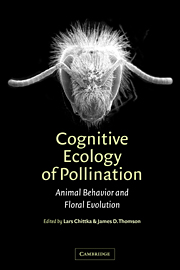Book contents
- Frontmatter
- Contents
- List of contributors
- Preface
- 1 The effect of variation among floral traits on the flower constancy of pollinators
- 2 Behavioral and neural mechanisms of learning and memory as determinants of flower constancy
- 3 Subjective evaluation and choice behavior by nectar-and pollen-collecting bees
- 4 Honeybee vision and floral displays:from detection to close-up recognition
- 5 Floral scent, olfaction, and scent-driven foraging behavior
- 6 Adaptation, constraint, and chance in the evolution of flower color and pollinator color vision
- 7 Foraging and spatial learning in hummingbirds
- 8 Bats as pollinators: foraging energetics and floral adaptations
- 9 Vision and learning in some neglected pollinators: beetles, flies, moths, and butterflies
- 10 Pollinator individuality: when does it matter?
- 11 Effects of predation risk on pollinators and plants
- 12 Pollinator preference, frequency dependence, and floral evolution
- 13 Pollinator-mediated assortative mating: causes and consequences
- 14 Behavioural responses of pollinators to variation in floral display size and their influences on the evolution of floral traits
- 15 The effects of floral design and display on pollinator economics and pollen dispersal
- 16 Pollinator behavior and plant speciation: looking beyond the “ethological isolation” paradigm
- Index
12 - Pollinator preference, frequency dependence, and floral evolution
Published online by Cambridge University Press: 13 August 2009
- Frontmatter
- Contents
- List of contributors
- Preface
- 1 The effect of variation among floral traits on the flower constancy of pollinators
- 2 Behavioral and neural mechanisms of learning and memory as determinants of flower constancy
- 3 Subjective evaluation and choice behavior by nectar-and pollen-collecting bees
- 4 Honeybee vision and floral displays:from detection to close-up recognition
- 5 Floral scent, olfaction, and scent-driven foraging behavior
- 6 Adaptation, constraint, and chance in the evolution of flower color and pollinator color vision
- 7 Foraging and spatial learning in hummingbirds
- 8 Bats as pollinators: foraging energetics and floral adaptations
- 9 Vision and learning in some neglected pollinators: beetles, flies, moths, and butterflies
- 10 Pollinator individuality: when does it matter?
- 11 Effects of predation risk on pollinators and plants
- 12 Pollinator preference, frequency dependence, and floral evolution
- 13 Pollinator-mediated assortative mating: causes and consequences
- 14 Behavioural responses of pollinators to variation in floral display size and their influences on the evolution of floral traits
- 15 The effects of floral design and display on pollinator economics and pollen dispersal
- 16 Pollinator behavior and plant speciation: looking beyond the “ethological isolation” paradigm
- Index
Summary
Pollinator responses to frequency – definitions and importance
Frequency-dependent selection (FDS) occurs when the relative fitness of a genotype or phenotype is a function of its frequency in the population (Wright 1948; Clarke 1962). In behavioral ecology, FDS usually indicates that the identity of the fittest genotype (or phenotype) reverses at some intermediate frequency (Heino et al. 1998). When rare genotypes have an advantage, in this narrow sense of FDS, such selection will result in stable polymorphic equilibria (Clarke & O'Donald 1964). This “negative” FDS has captured the interest of many evolutionary biologists (Ayala & Campbell 1974).
An example of a floral polymorphism believed to be maintained by FDS is heterostyly, a suite of floral traits including reciprocal style- and stigma-length polymorphisms. These polymorphisms can increase the amount of pollen carried to alternative phenotypes, causing rare morphs to have increased outcross mating opportunities (Heuch 1979; Eckert et al. 1996). Such selection arises purely from the architecture of the sexual organs, even if pollinators forage randomly among phenotypes. Levin (1972), however, suggested that behavioral preferences of the pollinators themselves might induce FDS among floral traits.
During the 1960s and early 1970s, a number of studies suggested that behavioral preferences were frequency-dependent (Ayala & Campbell 1974). Allen & Clarke (1968) showed that predators, especially birds, selected proportionately more of the most common prey types in a color-varying prey population, even if energetic rewards were equivalent for the different types.
- Type
- Chapter
- Information
- Cognitive Ecology of PollinationAnimal Behaviour and Floral Evolution, pp. 237 - 258Publisher: Cambridge University PressPrint publication year: 2001
- 39
- Cited by



